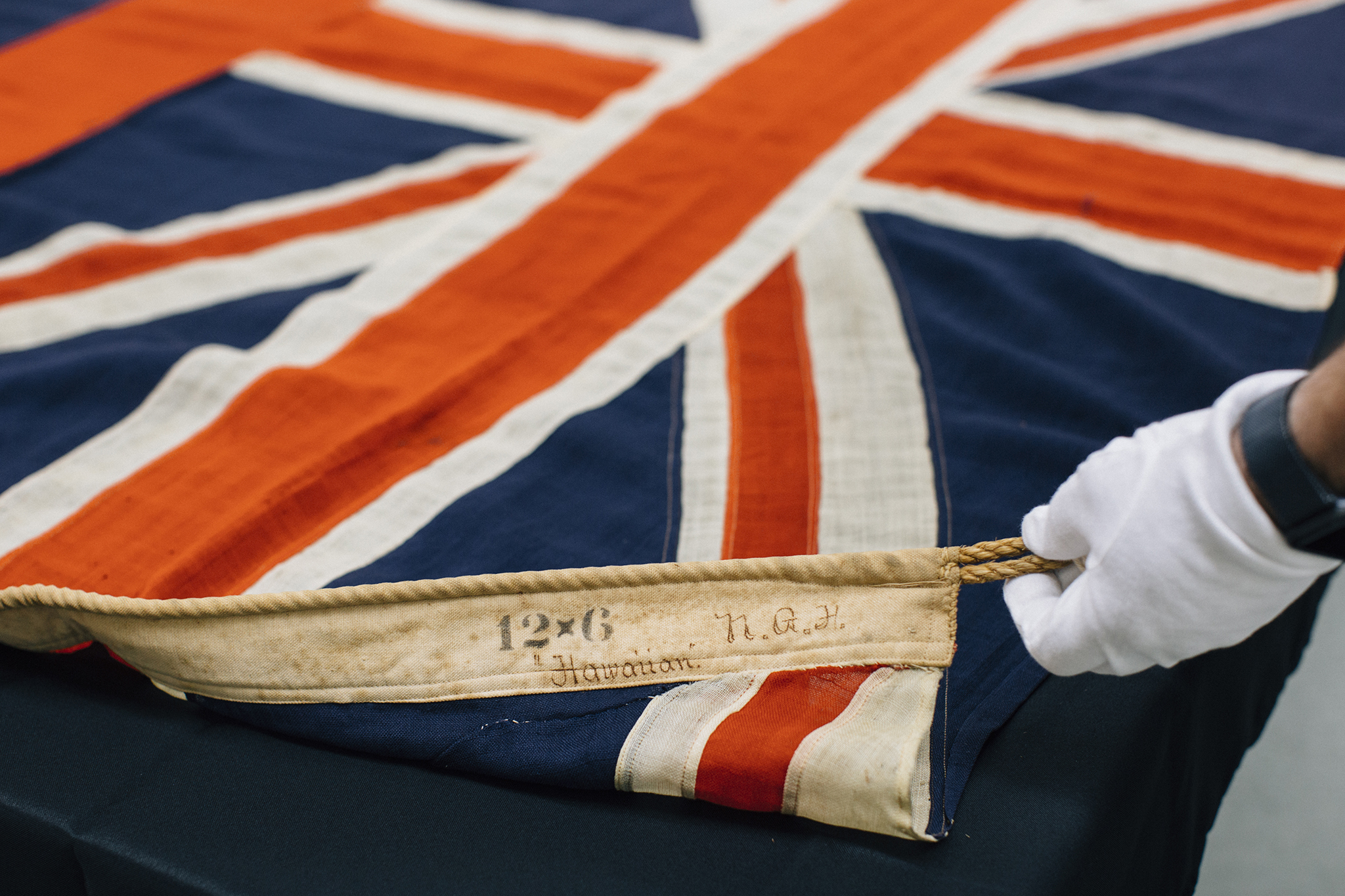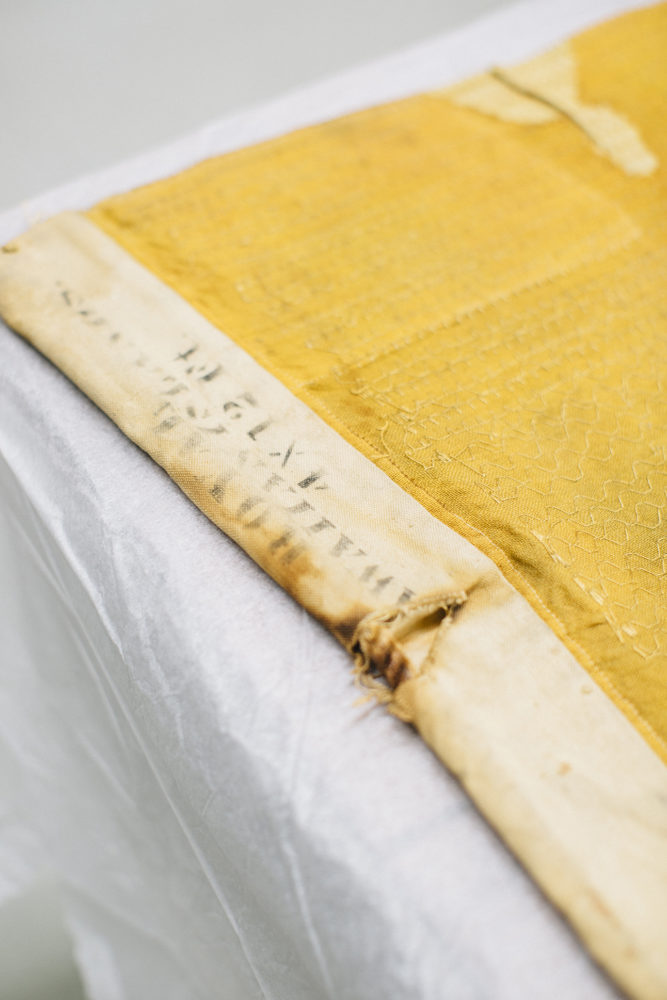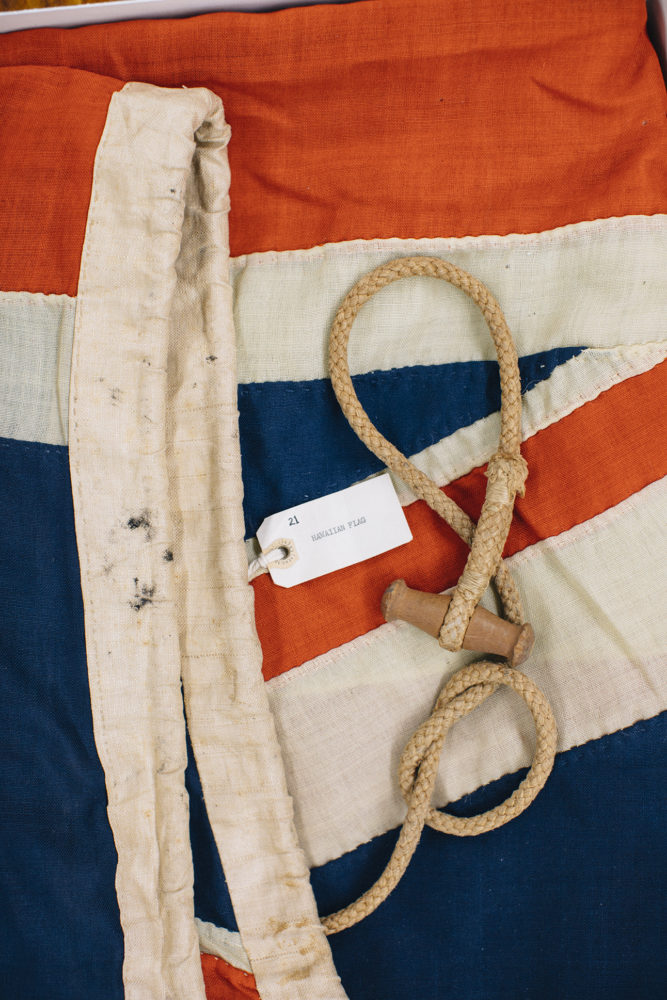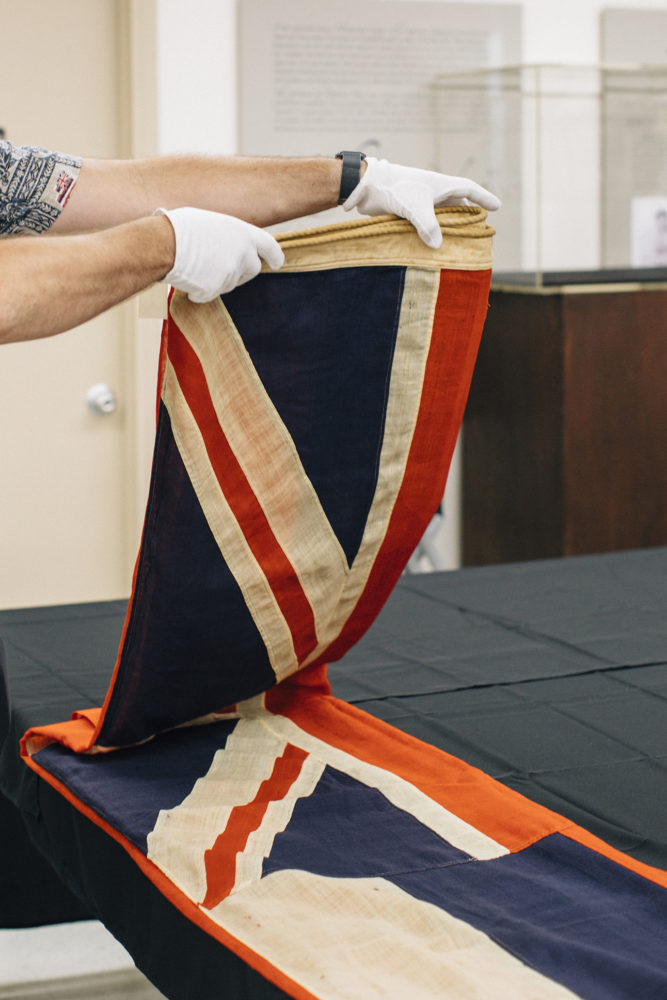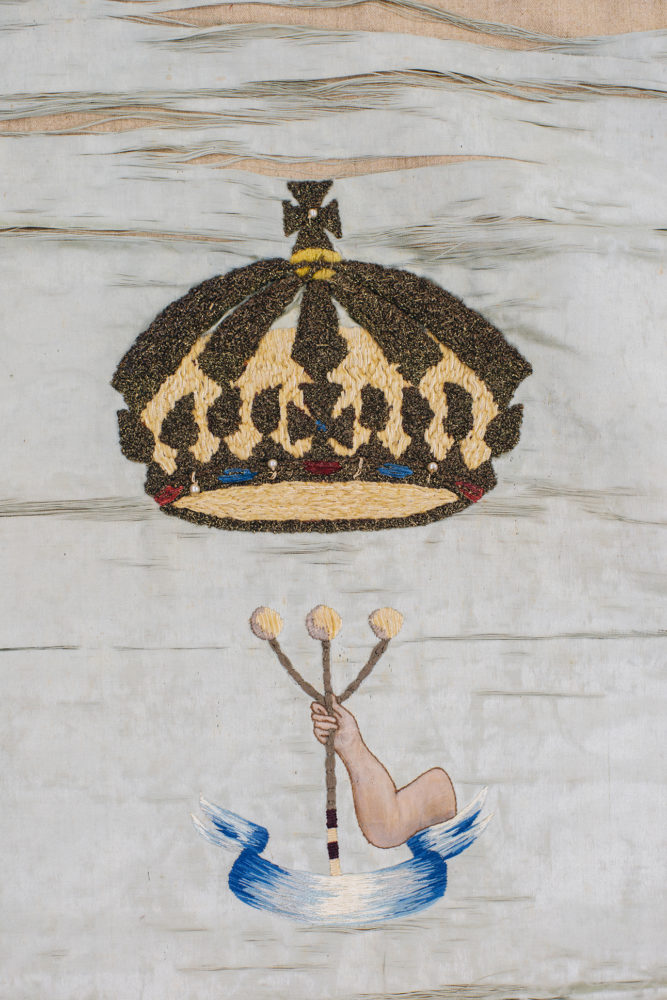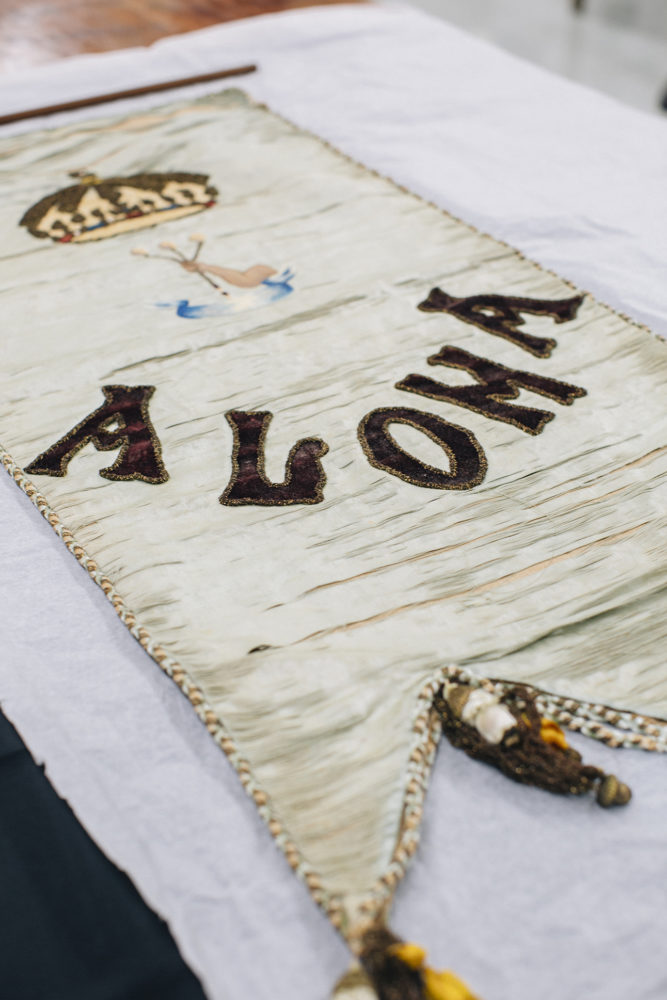Among its thousands of artifacts, the Hawai‘i State Archives preserves a royal collection of historic Hawaiian flags, banners, and standards.
“The story behind her majesty’s personal royal standard is one of the more intriguing stories that we have here,” says state archivist Adam Jansen.
He leads me from the check-in counter to the public viewing room in Kekāuluohi Building, a white, concrete and glass structure on the grounds of ‘Iolani Palace. The banyan-shaded building houses the Hawai‘i State Archives, which includes 14,000 cubic feet of mostly government records—Hawai‘i’s administrative history from the early Kingdom through U.S. statehood. The oldest document in the collection dates to 1790 and is an angry letter from British ship captain Simon Metcalf to four foreigners onshore threatening “ample revenge” if Kamehameha I refuses to release Metcalf’s officer.
Also in the archives are more than 1,000 artifacts, “absolutely amazing objects,” Jansen says, “that crystalize Hawai‘i’s history.” Among those is a collection of flags: royal standards, pageantry banners, and Hawai‘i national flags.
Unfurled on a table on the far side of the viewing room is a gold flag with the Hawaiian coat of arms stitched into its center. It was the personal royal standard of Queen Lili‘uokalani, Jansen explains, her heraldic flag that signified her presence wherever it was flown. (Queen Kapi‘olani and Princess Ka‘iulani also had royal standards.) It was flying over ‘Iolani Palace on January 17, 1893, the day the Hawaiian Kingdom government was overthrown.


After the palace’s flags were lowered on what Jansen calls “one of the darkest days in Hawaiian history,” the queen’s standard disappeared for 85 years. In 1978, it returned to Hawai‘i, and with it came a U.S. military sword, which Jansen had laid on the table beside her majesty’s standard. The gilt sword shines under the fluorescent lighting. Its hilt and sheath are ornamented and filigreed. It’s fancy.
The flag and the sword were donated to the state by the grandson of John Good Jr., the National Guard of Hawai‘i member who lowered the flags on January 17. (Good is also recorded as firing the only shot of the coup, at a policeman who stopped him en route to delivering weapons to the rebel militia.) When Good returned to the United States, so did the queen’s standard. There, it survived a house fire—Jansen points out burn patterns and the discoloration of the fabric—and was later inherited by Good’s grandson, who donated it to the West Point Museum in 1925, when he was attending the military academy. In 1940, it was fully restored by the museum.
Eighty-five years after John Good Jr. took the queen’s standard, his grandson returned it to Hawai‘i, along with his cadet sword. It’s “an incredibly powerful gesture,” Jansen says, and an example of how good can come from bad, “that there can be some understanding of what we can do to come together and move forward.”


What the flag represents, at its core, is the people.
Adam Jansen
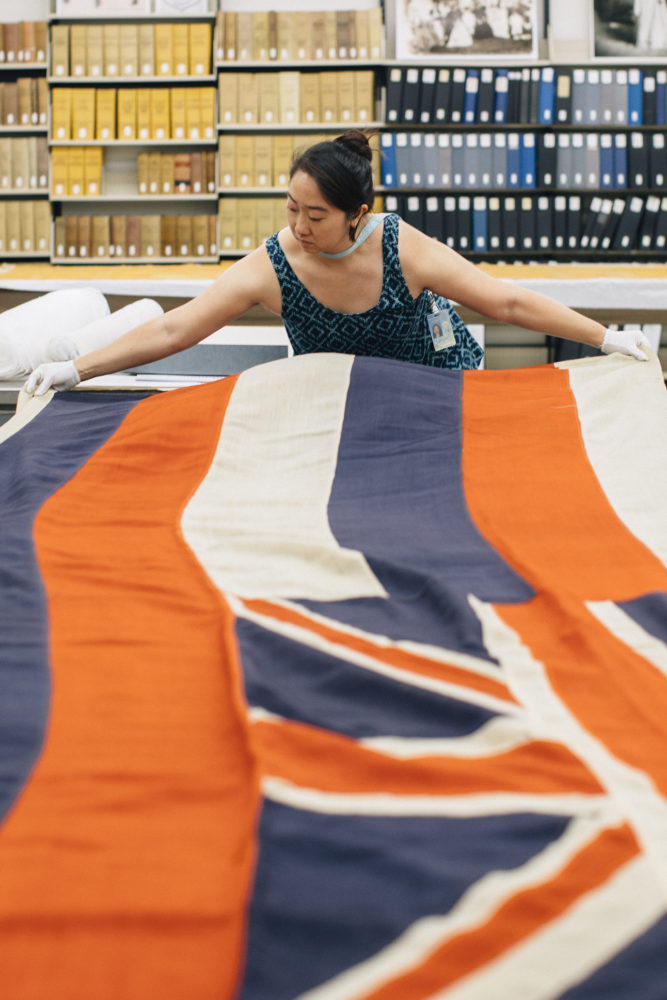

The next artifacts Jansen shows me also come from the Kingdom era: two pageantry banners made for a parade during King Kalākaua’s 1886 Royal Jubilee. The weeklong event marked his 50th birthday and was celebrated with feasts, races, hula, and philanthropic events.
One banner represented Lili‘uokalani’s Educational Society, which raised money for educating less fortunate Hawaiian women. The gold silk and cordoned edges of the 20-inch-by-40-inch banner sparkle against the white gloves Jansen wears when handling the delicate items. In appliquéd letters, the banner reads, “Hui Hoonaauao Liliuokalani, Mahele Elua, Nov. 16, 1886” (Lili‘uokalani Educational Society, Division 2, November 16, 1886); on the opposite side, which is light-green silk, it reads “ALOHA.” The other pageantry banner, made of red and gold silk, represented Queen Kapi‘olani’s hula troupe. It reads “Hula o Honuakaha {Ka Moiwahine} NOV 16, 1886” (Queen Kapiolani’s hula company of girls, November 16, 1886). Jansen explains that pageantry banners were as much for donors as they were for the beneficiaries; they gave benefactors a chance to rally around causes in which they’d invested.
The final pair of artifacts Jansen shows me are Hawaiian national flags, also known as the Flag of Hawai‘i, or Hae Hawai‘i (hae means flag in Hawaiian). It’s the flag most often associated with the islands, the one with the Union Jack in the corner and the eight horizontal stripes representing the archipelago’s eight islands.
Jansen first shows me the Hae Hawai‘i that was lowered from the ‘Iolani Palace barracks flagpole on Aug 12, 1898, an occasion the Pacific Commercial Advertiser marked with the headline, “Flags Changed: Old Glory is now the ensign of the Hawaiian Islands.”
Five years earlier, the rebels who overthrew the kingdom had adopted the Hae Hawai‘i as the flag of the Provisional Government, then as the flag of the Republic. When the U.S. took Hawai‘i under its jurisdiction, it came to represent the Territory of Hawai‘i. Jansen points out an inscription on its hoist and reads it aloud: And this was the flag that was lowered at noon on Annexation Day.
The second Hae Hawai‘i that Jansen unboxes is one that flew over the state capitol on August 21, 1959, statehood day. Jansen notes its thicker fabric and sturdy construction, explaining that it was a ceremonial flag, meant to fly for a short period of time in commemoration of a special occasion, later to be gifted to dignitaries. Hawai‘i didn’t get a new flag on August 12, 1959, but the United States did. The Star Bulletin celebrated Statehood Day with a full-page spread showing pictures of President Eisenhower unveiling a new American flag, one with an added 50th star to be released the following year.
Unlike the royal standards and pageantry banners, the Hae Hawai‘i represents all citizens of Hawai‘i. It’s been a symbol of the people during the Kingdom, through the Provisional Government and the Republic, through the Territorial Era, and up through statehood. Unlike the previous flags, it’s the only one that still flies today.
“Hawai‘i is still Hawai‘i,” Jansen says. “The form of government may have evolved, may have changed, but what the flag represents, at its core, is the people.”

